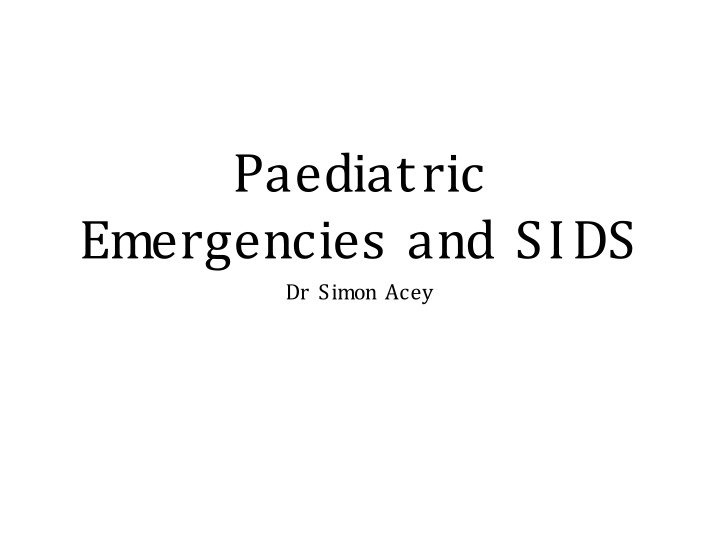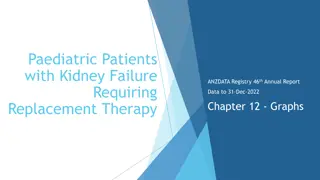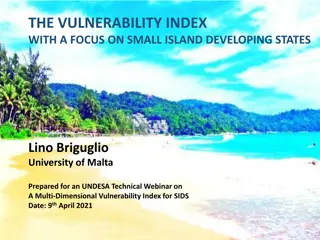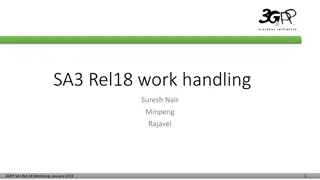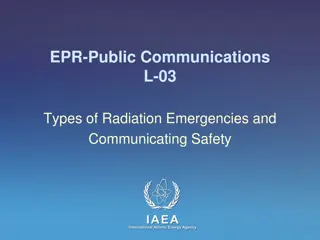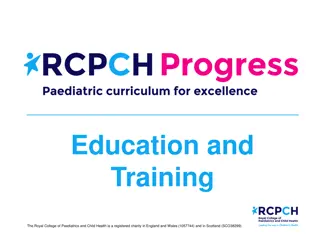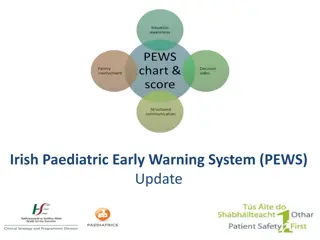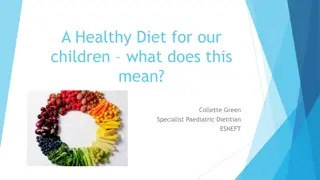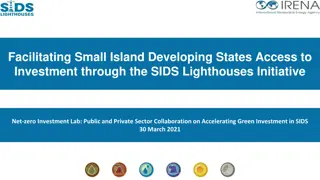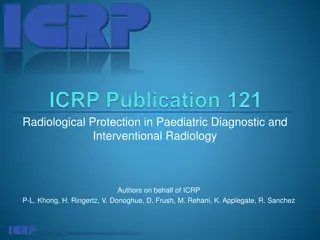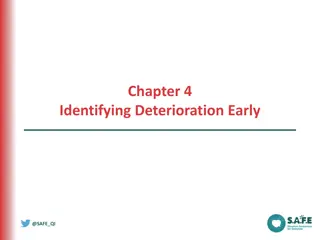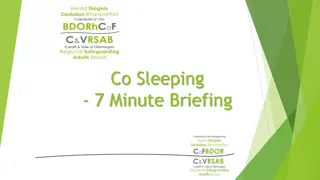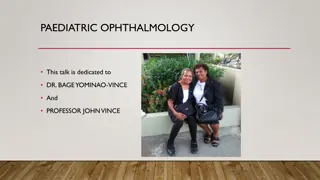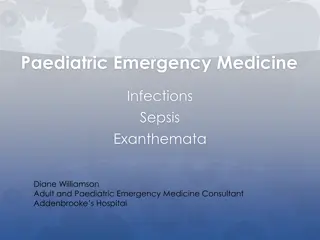Paediatric Emergencies and SIDS
Various types of paediatric emergencies seen in primary care and their management, including meningitis, pneumonia, congenital heart issues, and more. Learn about assessing a child's condition and using clinical tools for decision-making. Understand the importance of reflecting on Sudden Infant Death Syndrome (SIDS) and its current thinking.
Download Presentation

Please find below an Image/Link to download the presentation.
The content on the website is provided AS IS for your information and personal use only. It may not be sold, licensed, or shared on other websites without obtaining consent from the author.If you encounter any issues during the download, it is possible that the publisher has removed the file from their server.
You are allowed to download the files provided on this website for personal or commercial use, subject to the condition that they are used lawfully. All files are the property of their respective owners.
The content on the website is provided AS IS for your information and personal use only. It may not be sold, licensed, or shared on other websites without obtaining consent from the author.
E N D
Presentation Transcript
Paediatric Emergencies and SIDS Dr Simon Acey
Aims To look at some of the types of childhood emergencies that may be seen in primary care and consider their management To reflect on how GPs and the PHCT may be involved in SIDS
Objectives By the end of the session you should be able to, List the more important paediatric emergencies that may be experienced in primary care and how to manage them Be aware of objective criteria to use to assess the clinical condition of a child Have had an opportunity to practise a CSA style case Summarise current thinking about SIDS
What paediatric emergencies are there? Meningitis Pneumonia, bronchiolitis, asthma Congenital heart problems Abdominal pain - appendicitis, volvulus, intussusception Urinary tract infections Convulsions - febrile, epilepsy Inhaled foreign objects Sub-arachnoid haemorrhage Trauma, accidental poisoning, non-accidental injuries Anaphylaxis Metabolic - eg. diabetic emergencies
How can we assess the childs condition? Clinical experience - gut feeling Behaviour of the child Parental concerns Clinical assessment tool
Clinical assessment tool Signs reviewed, Activity Temperature Skin [capillary response time on chest] Respiratory rate SATs in air Chest recession Nasal flaring Grunting Pulses/heart rate Feeding/hydration Apnoeas Carers ability to act on deterioration
How may the assessment tool help us? It helps provide objective evidence for our decision making Can help us to track the condition of a child May be especially useful in the assessment of children with chronic health problems - can compare previous scores May help medico-legally May be useful for commissioning purposes and help in planning pathways
Limitations of the tool Objective measures [such as heart rate and respiratory rate] vary with age so the clinician must be aware of what are the normal ranges for each age Relies on appropriate equipment being easily available in the consulting room Takes time to assess properly especially in minor illness Decisions shouldn t just be based on the tool - clinician s judgement also valid and can over-ride apparently normal objective assessments
Cases in our practice Our practice has 12700 patients and is in an urban, deprived area. The following are some of the paediatric emergencies that we have been involved in
Case One The local paper s front page had a photo of an unhappy looking Mum in front of our surgery with her baby daughter in her arms. Baby with meningitis told she had chickenpox and sent home to take paracetamol! The practice manager recognised the Mum and daughter as being registered with our practice
Background to case one Mum had tried to get an appointment for the baby to be seen in the surgery in the morning - she had an appointment given for the afternoon but decided to go to the walk-in centre [which is in the same building]. The baby was reported to be off her food . The baby was seen by the nurse practitioner in the walk-in centre. She now had a rash and was advised that it was chickenpox and to treat her symptomatically. Mum went shopping and became more concerned as the baby seemed to be getting more unwell so she called an ambulance and was taken to A+E - she was admitted by paediatrics and a diagnosis was made of meningococcal meningitis.
What lessons can be learned from this case? Access to GP appointments and training of reception staff Use of the walk in centre Do we have injectable antibiotics available to give in an emergency? Are they in date? What are the current recommendations? Do we have appropriate resuscitation equipment? What follow up do the family need? What feedback do we give to the walk-in centre? Health promotion messages - use of practice newsletter, television screens, posters, local paper etc. Importance of vaccinations
Case Two A child was admitted to the paediatric day unit with a cough This was reviewed at the monthly practice commissioning meeting looking at targets set by the CCG
Background to case two A 15 month old baby was admitted to the PDU by one of the locums that had been working in the practice. He was admitted with a cough and wheeze. There was no Read coding of respiratory rate, temperature, pulse or pulse oximetry. There was a free text comment that the baby appeared tachypnoeic and that the parents were concerned. The boy was admitted and discharged on the same day. He was discharged with a salbutamol inhaler and spacer. He hasn t been seen in the surgery since the admission.
Lessons to learn from case two This may have been a preventable admission- the baby was only in PDU for a matter of hours. The importance of recording baseline information which helps to support the clinical decisions made. Consider feeding back to the locum. Check that the locum packs include the relevant information about clinical assessment tools and normal ranges of parameters. Also include details of where the relevant equipment [eg. paediatric pulse oximeter] is kept. Consider phoning parents to check on the progress of the baby.
Evidence to help with decision making Bronchiolitis in Children - SIGN reference guide 91 Indications for hospital admission, History of apnoea respiratory rate > 70/minute Nasal flaring or grunting Severe chest wall recession Cyanosis Oxygen saturation < 94% Uncertainty re diagnosis
Case Three An 8 year old girl collapsed while playing during the summer holidays. She was brought to the branch surgery by her father - they live just around the corner. The girl was unconscious on arrival. She stopped breathing soon after she was brought into the treatment room.
Background to case three The partner and registrar at the surgery performed CPR while the receptionist rang 999. The girl was admitted to hospital but unfortunately died there.
Reviewing the case Is the emergency equipment up to date in the branch surgery? What should be available? Were the staff up to date with their BLS training? Were the paramedics responsive? What follow up do the family need? What about the practice team?
What emergency equipment should be present in the surgery? Oxygen Defibrillator Nebuliser with salbutamol nebules Adrenaline Injectable benzylpenicillin and cefotaxime Rectal and injectable diazepam Injectable chlorphenamine Paediatric pulse oximeter Tympanic membrane thermometer and also temperature dots for babies Glucometer
CSA Case One Telephone consultation
CSA Case Two Parent attending for advice about their daughter who has recently been admitted to hospital
SIDS - Quiz 1. How many babies die from SIDS in the UK each year? A. 30 B. 100 C. 300 D. 1000 E. 3000 2. Is SIDS commoner in boys or girls? 3. List 5 possible risk factors for SIDS. 4. What does CONI stand for? 5. Is SIDS getting more or less common? 6. In which season is SIDS commonest? 7. Does the North-East have a high incidence of SIDS?
What is SIDS? Cot death is a term commonly used to describe a sudden and unexpected infant death that is initially unexplained. The equivalent medical term is Sudden Unexpected Death in Infancy [SUDI] . Some sudden and unexpected infant deaths can be explained by a thorough post mortem examination and other investigations. Cot deaths that remain unexplained after a thorough examination are usually registered as Sudden Infant Death Syndrome [SIDS] . Foundation for the Study of Infant Deaths [FISD]
Causes of cot death A thorough post mortem examination will reveal a specific cause of death in less than half of all cot deaths. Causes may include accidents, infection, abuse, congenital abnormality or metabolic disorder. For those that remain unexplained there are likely to be undiscovered factors or a combination of factors affecting a baby at a vulnerable stage of development.
Incidence of SIDS Commonest cause of death in the first year of life. The number of babies dying has fallen by over 70% over the last 25 years [it was stable at around 2 per 1000 live births from 1971-1988]. In 1996 the incidence was quoted at 0.7 cases per 1000 live births. By 2009 this had further dropped to between 0.3 and 0.6 per 1000 depending on the region.
Further facts Boys are 1.5 times more likely to die from SIDS than girls. 27% of deaths occur in winter; 22% in summer. 78% of deaths occurred in babies less than 3 months of age; 90% of deaths in babies less than 6 months of age. Babies with a low birth-weight of less than 2500g were 5 times more likely to die from cot death.
Differences between populations East of England has the lowest incidence in the UK [0.31 per 1000]; North-west the highest [0.59 per 1000]. Rate highest for mothers under the age of 20 [1.23 per 1000]. Cot deaths higher for fathers in routine and manual work - 3-4 times that of fathers in managerial and professional roles. Death rates higher in cities.
Possible risk factors Social class Age of mother Birth interval Parental smoking - over 60% of cases may be related to this Infection in pregnancy Maternal drug addiction Male infant Feeding intention - bottle or breast Maternal depression Prematurity or low birth-weight Multiple births Congenital defects Infant sleeping position Previous SIDS in the family Cold weather
Advice for reducing risk Three main strategies, Parental smoking - if can t stop then smoke outside. Overheating - avoid excessive clothing and bedding - bedroom shouldn t be too warm. Sleeping position - baby should sleep supine or on side if unable to sleep on back.
Unproven advice Breast feeding is probably limited as a protective factor. Concerns about toxic gases from mattresses are probably unfounded; loose covers may be hazardous.
CONI Care Of Next Infant A programme of support and care for parents who have lost a previous infant through cot death. Apnoea alarms Weekly visit from health visitor
CSA Case Three Support
Current Research Which genes are important in SIDS Long QT Syndrome in babies who have died as SIDS and their families Genetic, developmental and environmental risk factors in cytokine responses and SIDS The role of ambient air pollution in SIDS Car seats and SIDS Vitamin D deficiency
The case of Sally Clark Sally Clark was a solicitor in Manchester. She had 3 sons. Christopher was born in 1996 - he was found dead at home aged 12 weeks. Harry was born in 1998 - he was found dead at home aged 8 weeks. In both cases Sally was at home at the times of the deaths. Her third son was born in 1999. Sally was charged with the murder of her two older sons.
Court Trial Much of the evidence revolved around the statements of two doctors. Alan Williams was the Home Office pathologist. Roy Meadows was an expert witness.
Roy Meadows Roy Meadows stated One infant death in a family is a tragedy, two is suspicious and three is murder unless proven otherwise [Meadow s Law] He went on to say, For an affluent, non-smoking family the probability of a single cot death is around 1:8543 so the probability of two cot deaths is around 1:73 million [8543x8543] These odds are analogous to backing an 80 to 1 outsider in the Grand National 4 years in a row and winning each year!
Outcome Sally was found guilty of double infanticide in 1999 and sentenced to life imprisonment
Doubts It was found that the prosecuting pathologist knew [in 1998] that Harry had been colonised with staph. aureus but had failed to disclose this information. It was felt that this might have played a causative role in Harry s death In October 2001 the Royal Statistical Society issued a public statement expressing its concern at the misuse of statistics in the courts. In particular it felt there was no statistical basis for Roy Meadows statements. An independent statistician reviewed the current evidence around SIDS incidence. Meadows statement had been based upon two SIDS in a family being independent of each other. In fact research actually suggested that the incidence of one cot death in a family increased the risk of further SIDS by a factor of between 5 and 10.
Outcome Sally Clark was freed on appeal in J anuary 2003 The Attorney General subsequently reviewed similar convictions of other women and 3 other mothers [at whose trials Roy Meadows had given evidence] were released. Roy Meadows was struck off in 2005 [and re-instated on appeal in 2006] Alan Williams was banned from home Office work in 2005 for 3 years
Outcome continued In 2007 Sally Clark died
Quiz answers 1. 300 2. Boys 3. Social class; age of mother; birth interval; parental smoking; infection in pregnancy; maternal drug addiction; male infant; feeding intention; maternal depression; prematurity or low birth-weight; multiple births; congenital defects; infant sleeping position; previous SIDS; cold weather 4. Care of Next Infant 5. SIDS is getting less common 6. SIDS is commonest in the winter 7. The North-East has a relatively low incidence of SIDS
References Generic clinical assessment tool for children - Traffic light system for identifying severity of illness Feverish illness in children - NICE clinical guideline 47, May 2007 - www.nice.org.uk/CG047 Bronchiolitis in children - SIGN reference guide 91, November 2006 - www.sign.ac.uk The Condensed Curriculum Guide - Riley et al, RCGP, 2007 GP Notebook FSID - www.fsid.org.uk
Conclusions This afternoon we have, Reviewed the commoner childhood emergencies and considered cases that have occurred in our practice Looked at using the generic assessment tool in managing an ill child Considered the risk factors in SIDS and the role of the GP in trying to help support families to prevent SIDS Practised CSA cases
Thank you! Feedback forms please
